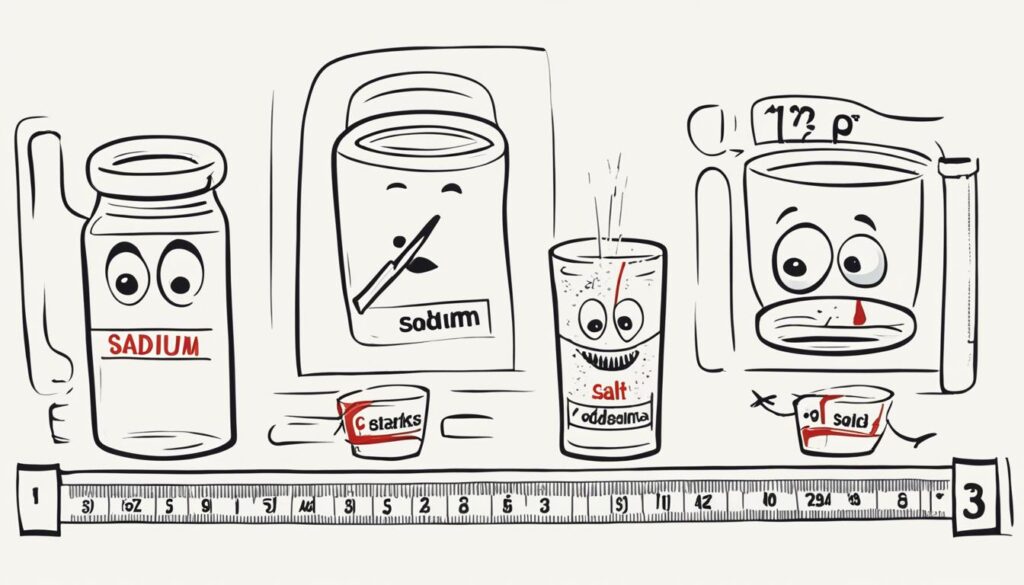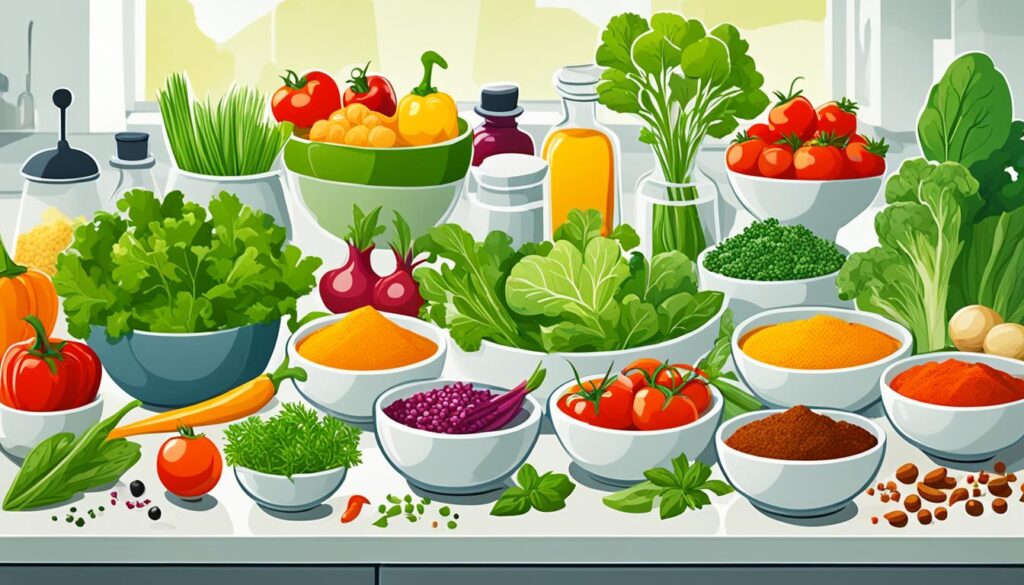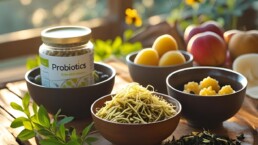Medically reviewed by Dr Chandril Chugh,
Renowned Neurologist and American Trained Specialist
Nine out of 10 Americans consume more sodium than they need, which can lead to high blood pressure and increase the risk of heart attack and stroke. Cutting down on sodium is essential for maintaining a healthy heart. Here are 50 quick tips to help you reduce your daily sodium intake and improve your overall health.
Table of Contents
ToggleKey Takeaways:
- Reducing daily sodium intake can lower blood pressure and boost overall health.
- Knowing your sodium limit is important for effective reduction.
- Choose lower-sodium options while shopping for processed foods.
- Check the Nutrition Facts label to compare sodium content.
- Make healthy substitutions and use herbs and spices for flavor.
1. Know Your Sodium Limit
It is important to know your sodium limit in order to effectively reduce your intake and maintain a healthy lifestyle. The recommended daily intake of sodium varies for different age groups and individuals. By understanding your sodium limit, you can make informed choices about the foods you consume and take steps to lower your sodium intake.
Here is a general guideline for sodium limits:
| Age Group | Sodium Limit |
|---|---|
| Children (1-3 years old) | 1,500 milligrams per day |
| Children (4-8 years old) | 1,900 milligrams per day |
| Children (9-13 years old) | 2,200 milligrams per day |
| Teenagers (14-18 years old) | 2,300 milligrams per day |
| Adults | 2,300 milligrams per day |
| Adults (age 51 and older) | 1,500 milligrams per day |
These recommendations take into account the potential risks associated with high sodium intake, such as high blood pressure and heart disease. By staying within your sodium limit, you can help protect your health and promote overall well-being.

2. Shop for Lower-Sodium Foods
Most of the sodium in our diet comes from processed and prepared foods, even those that don’t taste salty. When shopping, it’s important to choose lower-sodium options and be mindful of the sodium content in the foods you purchase. By selecting foods that are labeled “low sodium” or “no salt added,” you can significantly reduce your sodium intake without compromising on taste.
Limiting or avoiding high-sodium foods is crucial for maintaining a healthy lifestyle. Processed meats, sauces, dressings, and instant flavored foods tend to have high sodium content. By opting for lower-sodium alternatives, you can still enjoy flavorful meals while keeping your sodium intake in check.
Lower-Sodium Food Options:
- Fresh and frozen fruits and vegetables
- Whole grains
- Unsalted or low-sodium nuts
- Lean meats, poultry, and seafood
- Low-sodium or no salt added canned beans and vegetables
- Low-sodium or reduced-sodium soups and broths
- Low-sodium condiments, such as mustard, vinegar, or homemade dressings
- Low-sodium dairy products
When making food choices, always refer to the nutrition labels to assess the sodium content. It’s important to be aware that some lower-sodium foods may not have specific labels. In such cases, checking the Nutrition Facts label will provide accurate information about the sodium content.
| High-Sodium Foods to Limit or Avoid | Sodium Content (per serving) |
|---|---|
| Processed meats (e.g., bacon, sausages, hot dogs) | Varies; can range from 400-800mg or more |
| Canned soups and broths | Varies; can range from 600-1000mg or more |
| Sauces and dressings | Varies; can range from 200-1000mg or more |
| Instant flavored foods (e.g., noodles, rice mixes) | Varies; can range from 400-1000mg or more |
3. Check the Label
When it comes to reducing your sodium intake, it’s important to be aware of the nutrition content of the foods you consume. The Nutrition Facts label provides crucial information about sodium content, allowing you to make informed choices and opt for low-sodium options. Here’s how you can utilize the label:
1. Read the Sodium Content
Take a close look at the “Sodium” section on the label. It indicates the amount of sodium present in the food per serving. Pay attention to the serving size to ensure accurate calculations for your sodium intake.
2. Compare Different Options
Use the Nutrition Facts label to compare sodium content between different brands or products. Choose the ones with lower sodium content to help regulate your daily intake.
3. Aim for 5% Daily Value (DV) or Less
The Daily Value (DV) percentage shown on the label represents the amount of sodium in a serving compared to the recommended daily limit. Aim for products with 5% DV or less, as this indicates a lower sodium content.
By checking the Nutrition Facts label, you can easily identify low-sodium options and make healthier choices for your diet. However, it’s important to note that some lower-sodium foods may not have specific labels. In such cases, always refer to the Nutrition Facts label to accurately determine the sodium content to align with your dietary needs.
4. Make Healthy Shifts
When it comes to reducing your sodium intake, making healthy substitutions is key. By replacing high-sodium foods with healthier alternatives, you can still enjoy delicious meals while improving your overall health.

1. Opt for Unsalted Nuts
Instead of reaching for salted snacks like chips or pretzels, choose unsalted nuts such as almonds, walnuts, or pistachios. Not only are they a crunchy and satisfying snack, but they also provide beneficial nutrients like healthy fats and protein.
2. Cook Fresh or Frozen
When preparing meals, opt for fresh or frozen chicken, lean meats, or seafood instead of deli meats, sausages, or other processed options. Fresh cooking allows you to control the amount of sodium in your meals and enjoy the natural flavors of the ingredients.
3. Use Fresh Vegetables
Incorporate fresh vegetables into your meals whenever possible. They not only add vibrant colors and textures but also bring a wealth of vitamins and minerals to your plate. If fresh vegetables aren’t readily available, choose frozen vegetables without added sauces or canned vegetables with lower sodium content.
4. Explore Herbs and Spices
Herbs and spices are a great way to add flavor to your meals without relying on salt. Experiment with different combinations to create delicious and satisfying dishes. Some popular options include basil, oregano, garlic, cumin, and turmeric.
By incorporating these healthy shifts into your cooking routine, you can reduce your sodium intake while still enjoying flavorful and nutritious meals.
| High-Sodium Foods to Replace | Healthier Substitutions |
|---|---|
| Deli meats and sausages | Fresh or frozen chicken, lean meats, or seafood |
| Salted snacks like chips | Unsalted nuts (almonds, walnuts, pistachios) |
| Processed sauces and dressings | Homemade dressings using herbs and spices |
| Sodium-laden canned vegetables | Fresh vegetables or frozen vegetables without sauce |
5. Cook More at Home
Cooking your own meals gives you control over the sodium content. By preparing homemade meals, you can ensure that you are using ingredients with lower sodium levels and avoiding excessive salt. This way, you can take care of your health and enjoy delicious food.

When cooking at home, it’s important to pay attention to the sodium content of the ingredients you use. Here are some tips to help you control the sodium in your homemade meals:
- Choose unsalted or lower-sodium condiments and spreads for cooking and seasoning.
- Experiment with a variety of herbs and spices to enhance the flavor of your dishes without relying on salt.
- Rinse canned foods under running water to wash away some of the salt before using them in your recipes.
- Opt for fresh fruits, vegetables, and meats instead of canned or processed options, as they usually have higher sodium levels.
Making your own meals not only allows you to control the sodium content but also gives you the opportunity to explore different flavors and be creative in the kitchen. By reducing your reliance on processed and prepared foods, you can significantly lower your sodium intake and improve your overall health.
| Benefits of Cooking at Home | Tips for Sodium Control |
|---|---|
| 1. Healthier ingredients | 1. Choose unsalted or lower-sodium condiments |
| 2. Lower sodium intake | 2. Experiment with herbs and spices |
| 3. More affordable | 3. Rinse canned foods |
| 4. Increased culinary skills | 4. Opt for fresh ingredients |
6.Get Less Salt When Eating Out
When dining out, there are several strategies you can employ to reduce your sodium intake and make healthier choices. Opting for lower-sodium options on the menu is a great way to enjoy a delicious meal while keeping your sodium intake in check. Look for dishes that are labeled as “low sodium” or “reduced sodium” to ensure you are making a healthier choice.
If you’re concerned about the amount of salt added to your food, don’t be afraid to ask the restaurant staff to prepare your meal without salt. Many restaurants are willing to accommodate special requests, and this simple action can significantly reduce your sodium intake.
Another way to control your sodium intake when eating out is to request dressings and sauces on the side. By adding these condiments sparingly, you can control the amount of sodium you consume. This is especially important because dressings and sauces can often be high in sodium. Taking control of these additions allows you to enjoy the flavors without overdoing it on salt.
Being mindful of sodium when eating out is an important part of maintaining a healthy lifestyle. By seeking lower-sodium options, requesting no salt, and controlling dressings and sauces, you can make smarter choices and continue to prioritize your health and well-being.
7. Add More Potassium to Your Diet
Including potassium-rich foods in your diet is not only delicious but also beneficial for your overall health. Potassium has been shown to help lower blood pressure and support kidney health. By incorporating these potassium-rich foods into your meals, you can counterbalance the negative effects of high sodium levels and promote a healthier lifestyle.
Here are some excellent sources of potassium:
- Potatoes
- Cantaloupe
- Bananas
- Beans
- Milk
- Yogurt
These foods are not only rich in potassium but also versatile, making it easy to incorporate them into your daily meals. Whether you enjoy them as a side dish, snack, or part of a recipe, they can help support your kidney health and maintain healthy blood pressure levels.
| Food | Potassium Content (per 100g) |
|---|---|
| Potatoes | 429 mg |
| Cantaloupe | 267 mg |
| Bananas | 358 mg |
| Beans | 429 mg |
| Milk | 150 mg |
| Yogurt | 249 mg |
By incorporating these potassium-rich foods into your daily meals, you can enjoy a variety of flavors while reaping the health benefits. Remember, a balanced diet that includes potassium-rich foods alongside reducing sodium intake is key to maintaining a healthy lifestyle.
Conclusion
Reducing daily sodium intake is crucial for maintaining a healthy lifestyle and preventing chronic conditions such as high blood pressure. By following these 50 quick tips, you can gradually lower your sodium intake and experience long-term health benefits.
Start your low-salt journey today and prioritize your heart health. By knowing your sodium limit, shopping for lower-sodium foods, and checking the labels, you can make informed choices and reduce your sodium intake.
Additionally, making healthy shifts in your diet, cooking more at home, and getting less salt when eating out will contribute to your overall sodium control. Remember to add more potassium-rich foods to counterbalance the effects of high sodium levels.
Embracing these lifestyle changes will not only improve your immediate health but also have long-term benefits. So, take charge of your well-being and start reducing sodium now for a healthier, happier future.
FAQ
What are some quick tips for reducing daily sodium intake?
Follow these 50 quick tips to gradually lower your sodium intake and boost your overall health.
How do I know my sodium limit?
It is important to know your sodium limit to effectively reduce your intake. The recommended daily intake varies for children and adults. Consult with a healthcare professional to determine your specific sodium limit.
How can I shop for lower-sodium foods?
When shopping, choose lower-sodium options and look for foods labeled “low sodium” or “no salt added.” Be aware that most of the sodium in our diet comes from processed and prepared foods, even those that don’t taste salty.
How can I check the sodium content in foods?
Use the Nutrition Facts label to check the amount of sodium in foods and compare different options. Aim for products with 5% Daily Value (DV) or less. Look for foods labeled “low sodium” or “no salt added.” Some lower-sodium foods may not have specific labels, so always check the Nutrition Facts label for accurate sodium content.
What are some healthy substitutions for high-sodium foods?
Instead of salted snacks, opt for unsalted nuts. Cook fresh or frozen chicken, lean meats, or seafood instead of deli meats or sausages. Use fresh vegetables, frozen vegetables without sauce, or canned vegetables with lower sodium. Explore different herbs and spices to flavor your food and reduce the reliance on salt.
How can cooking more at home help reduce sodium intake?
Cooking your own meals gives you control over the sodium content. Rinse canned foods to wash away some of the salt. Choose unsalted or lower-sodium condiments and spreads, and experiment with herbs and spices to enhance flavor. By reducing reliance on processed and prepared foods, you can significantly lower your sodium intake.
How can I get less salt when eating out?
When dining out, seek lower-sodium dishes on the menu or ask for your food to be prepared without salt. Request dressings and sauces on the side so you can add them sparingly. Being mindful of sodium when eating out helps maintain your overall intake.
What are some potassium-rich foods I can add to my diet?
Include more potassium-rich foods in your diet to help lower your blood pressure and support kidney health. Good sources of potassium include potatoes, cantaloupe, bananas, beans, milk, and yogurt. Increasing potassium intake can counterbalance the negative effects of high sodium levels.
What are the benefits of reducing daily sodium intake?
Reducing daily sodium intake is vital for maintaining a healthy lifestyle and preventing chronic conditions such as high blood pressure. By following these tips, you can gradually lower your sodium intake and experience long-term health benefits.
Source Links

Dr Chandril Chugh
Dr. Chandril Chugh is a U.S.-trained neurologist with over a decade of experience. Known for his compassionate care, he specializes in treating neurological conditions such as migraines, epilepsy, and Parkinson’s disease. Dr. Chugh is highly regarded for his patient-centered approach and dedication to providing personalized care.




